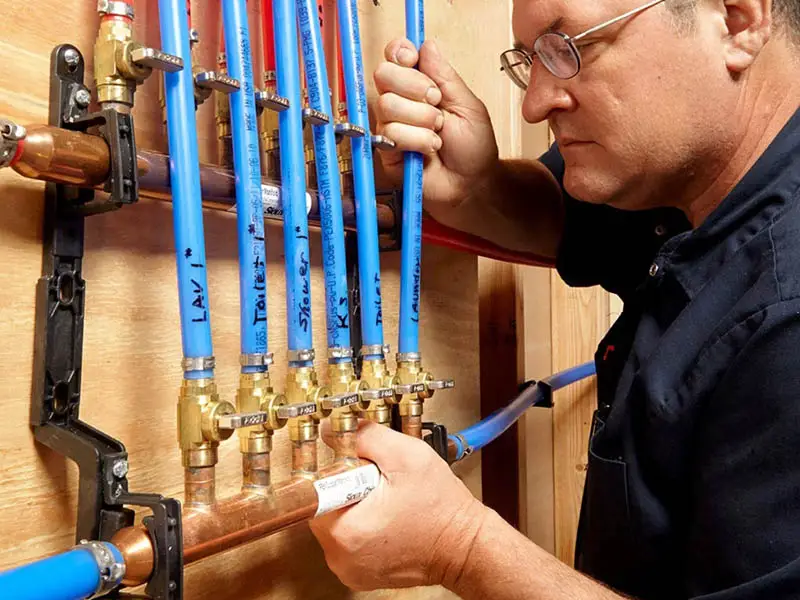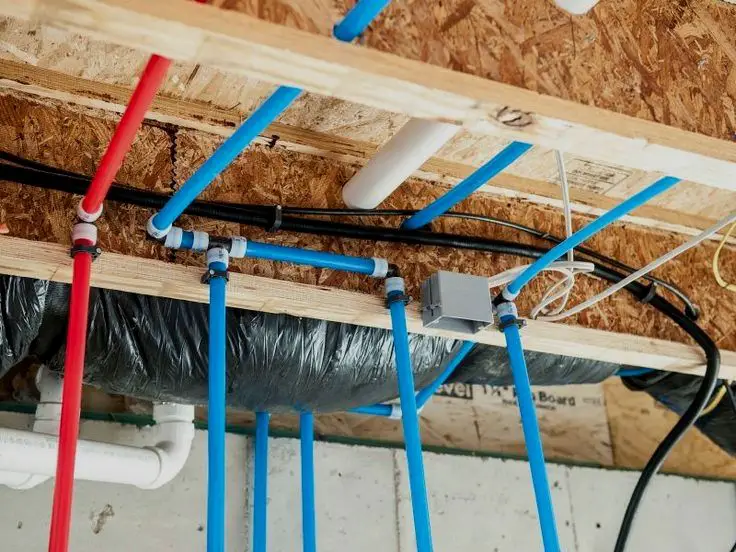What Is Pex Plumbing
Introduction
Pex plumbing, also known as cross-linked polyethylene plumbing, is a modern plumbing system that has gained popularity in recent years. It is a flexible and durable alternative to traditional plumbing device systems, such as copper and galvanized steel.
Pex plumbing pipes are made from a high-density polyethylene material that has been cross-linked. This process creates a stronger and more resilient pipe that is resistant to cracking, bending, and corrosion. The cross-linking also allows for increased flexibility, making it easier to install in tight spaces and around corners.
One of the main advantages of Pex plumbing is its ease of installation. The flexibility of the pipes allows for easier and quicker installation, reducing labor costs and time. Pex plumbing also requires fewer fittings compared to traditional plumbing systems, as the pipes can be bent and curved to fit the layout of the building. This not only makes installation easier but also reduces the chances of leaks, as there are fewer connections that can potentially fail.
Another benefit of Pex plumbing is its resistance to freezing and bursting. The flexibility of the pipes allows them to expand and contract with temperature changes, reducing the risk of cracks and leaks caused by freezing water. This makes Pex plumbing an excellent choice for cold climates or areas prone to freezing temperatures.

What Is Pex Plumbing Used For?
People use PEX pipe for many things, like city water service lines, radiant panel heating systems, hydronic floor heating systems, systems that melt snow and ice, and building services pipe. It can also be used to set up systems in homes and companies that bring hot and cold water to people.
Pex plumbing is used in many ways in homes, companies, and factories. It can be used for many plumbing tasks because it is strong and bendable.
A lot of home water systems use Pex pipes. It can connect items like dishwashers and washing machines to water sources, as well as taps, toilets, and showers. It’s easy to put Pex pipes in small spaces because they are flexible. You can use them for both new and old projects because of this. A lot of the time, Pex plumbing is used in radiant floor heating systems. These systems heat floors evenly and effectively by running hot water through Pex lines below the floor.
People often use Pex plumbing in big water systems in business and industry. It can connect water lines and carry chemicals, gases, and other fluids. It works well for these tasks because it doesn’t rust or mix with acids.
Pex plumbing is also often used in the water systems of mobile houses and RVs. Because it is flexible and doesn’t freeze, it works great for these tasks. The plumbing needs to be able to handle temperatures that go up and down.
What Are The Disadvantages Of Pex Pipe?
Of course, PEX piping does carry some disadvantages. It will crack and break apart under the influence of strong UV rays (making it unsuitable for most outdoor use). Plumbers require specialized tools to cut and join this type of modern pipe. Additionally, disposing of used PEX pipe sometimes proves problematic.
Pex pipes should not be used outdoors or in exposed applications because sunlight can damage and brittle them. Protecting pipes from UV rays requires shielding or burying them.
Pex plumbing costs more than standard plumbing materials, another drawback. Pex pipes cost more initially, but they last longer, require fewer fittings, and resist corrosion and freezing.
Furthermore, Pex pipes are unsuitable for high-temperature applications. Compared to copper pipes, they can distort or melt at high temperatures. Installing Pex pipes away from furnaces and hot water heaters is crucial.
Rodents can damage Pex pipes more. Although robust and resistant to cracks and leaks, rodents can eat through pipes if they get in. Protecting Pex plumbing systems from rodent damage requires sealing entrance points and taking safeguards.
Is Pex Plumbing Good?
PEX is the most lasting pipe material on the market right now because it doesn’t rust, pit, or scale, and it doesn’t freeze. Because it is flexible, it cuts down on connections by up to half in some situations. This makes it one of the fastest ways to place pipes.
People think that Pex plumbing is a good choice for many reasons. There are many good things about it that make homeowners, builders, and plumbers like it.
A big part of why Pex plumbing is thought to be good is that it’s easy to set up. Pex pipes are easier and faster to install than standard plumbing materials like copper or galvanized steel because they are flexible. The pipes are easy to bend and curve to fit the building’s plan, so they don’t need as many extra fittings and connections. This not only saves time but also makes it less likely that there will be leaks or other problems.
Another good thing about Pex plumbing is that it lasts a long time. Cracking, bending, and corrosion can’t happen to Pex lines, so the plumbing system will last a long time. They won’t break in freezing weather, so they’re good for places that get cold. Also, chemicals and chlorine can’t damage Pex lines over time, but they can damage other types of pipes. Because they last longer, the plumbing system will need less upkeep and replacement over its lifetime.
In addition, Pex plumbing has great water strength and flow capacity. The smooth inside of the pipes cuts down on friction, which makes the water flow and high-pressure supply work well. In the end, this can lead to better water economy and less energy use.

Why Do Plumbers Not Use PEX?
Even though PEX pipes are thick, rat damage can shatter or break them. Although rare, some households and plumbing businesses have reported PEX pipes leaching BPA (Bisphenol A) into the water supply.
PEX piping is used for many plumbing applications, however some plumbers may not utilize it for a few reasons.
Lack of experience with PEX is one reason plumbers may not utilize it.
Another reason why some plumbers may not use PEX is the concern about potential long-term effects on water quality. While PEX plumbing is generally considered safe and approved for use with potable water, some plumbers may have concerns about the potential for leaching of chemicals or taste changes in the water. However, it is important to note that PEX plumbing has been extensively tested and meets all necessary safety standards.
Additionally, some plumbers may be hesitant to use PEX due to its susceptibility to UV radiation. PEX pipes should not be exposed to direct sunlight or used in outdoor applications without proper protection. This limitation can make PEX less appealing in certain situations, especially for plumbers working on projects that involve outdoor plumbing or exposed pipes.
What Is The Difference Between Pex And Ppr?
PPR is a pipe made of polypropylene random copolymer. They can be used in plumbing and industrial systems that use hot and cold water under pressure. PEX is a cross-linked type of polyethylene. Most of the time, it’s used in plumbing systems for buildings, hydronic heating and cooling systems, and home water pipes.
Different types of pipe materials, Pex (cross-linked polyethylene) and PPR (polypropylene random), are used for different tasks. They are alike in some ways, but they are also different in other ways.
The way they are made is one big difference between Pex and PPR. Polyethylene molecules are cross-linked to make Pex pipes. This makes the pipes stronger and last longer. The random copolymerization of propylene, on the other hand, makes PPR pipes, which are stiffer and can handle heat better.
The pipes can bend, which is another change. Pex pipes are very bendable, which makes them easy to install and bend around corners and other objects. They are especially helpful for remodeling or retrofitting jobs that need to be flexible. PPR pipes, on the other hand, are less flexible and are usually used for water systems that are more rigid.
Another difference is that Pex and PPR pipes can handle different temperatures. It’s not possible for Pex pipes to freeze or burst, and they can handle both hot and cold conditions. For use with both hot and cold water, they are ideal. PPR pipes, on the other hand, can handle hot water that is hotter because they can handle more heat. They are often used in plumbing systems that use hot water, like to give water to showers and taps.
Can Pex Plumbing Be Used For Outdoor Applications?
Outdoor use of PEX plumbing is not advised unless it is properly protected from UV rays. Sunlight can hurt PEX pipes if they are left out in the sun for a long time. The material can break down and become brittle because of the UV rays, which makes it more likely that it will crack or leak.
To keep UV rays from damaging PEX wiring that is used outside, it should be covered or buried. The sun’s rays can damage the pipes, but they can be kept safe by putting them in a dark area or covering them with insulation or conduit. Additionally, burying the pipes at the right level can add an extra layer of defense.
It is important to remember that PEX plumbing can still be used for plumbing jobs outside as long as they are properly protected. On the other hand, PEX lines can be used in irrigation systems, where they are buried and out of direct sunlight. Because PEX lines are flexible and long-lasting, they can be used in these situations as long as the right steps are taken to protect them from UV light.
Talking to a professional plumber or contractor who has done outdoor plumbing improvements before you start is always a good idea. They can give you advice on how to install the PEX plumbing system correctly and what safety measures you need to take to make sure it lasts and works well.
How Does Pex Plumbing Work?
Water moves through a system of flexible Pex lines, fittings, and valves to make Pex plumbing work. Cross-linked polyethylene is used to make the pipes, which makes them stronger and more flexible.
Putting in the pipes is the first step in Pex plumbing. With the right tool, you can quickly cut Pex pipes to the length you need, and they come in different sizes to meet all of your plumbing needs. After that, crimp, clamp, or push-fit joints are used to connect the pipes to the fittings. These connections keep the lines and fittings together and seal out water.
The pipes can be hooked up to the water supply line once they are set up. This is usually done with a manifold system, which is where the water flow is centralized. The manifold lets different parts of the building handle and turn off their own water supplies.
The water runs through the Pex pipes from the manifold to fixtures like faucets, toilets, showers, and laundry machines. The smooth inside of the pipes makes sure that water flows smoothly with little resistance, which leads to good water strength and distribution.
You can also use Pex plumbing devices to get hot water. The hot water from the water heater is sent to the fixtures through a different set of Pex pipes. Most of the time, the hot water pipes are marked with a different color than the cold water lines.
Is Pex Plumbing Safe For Drinking Water?
People think that drinking water can go through Pex pipes. Cross-linked polyethylene is used to make Pex pipes. This material has been tried a lot and is safe to use with potable water. There are safety rules and standards that must be followed for plumbing systems in homes, businesses, and factories that use Pex lines.
Chemical and corrosion protection is a big part of the reason why Pex plumbing is thought to be safe for drinking water. Chemicals found in water, like chlorine, can damage or leak through other types of pipes, but Pex pipes don’t get damaged by these chemicals. Pex pipes stay structurally sound and don’t let dangerous chemicals into the water because of the cross-linking process that is used to make them.
The problems that come with other types of plumbing materials, like lead contamination from lead pipes or copper leaching from copper lines, don’t happen with Pex plumbing either. Since Pex lines don’t have any lead or copper in them, they are a safe way to move drinking water.
In addition, Pex plumbing is known for not letting bacteria grow on it. There is no place for bacteria or biofilm to grow in Pex pipes because the inside is clear. These substances can contaminate the water supply. Being careful about this can help keep the drinking water clean and safe.

Conclusion
Pex plumbing, also known as cross-linked polyethylene plumbing, is a modern and innovative plumbing system that offers numerous advantages over traditional plumbing materials. Its flexibility, durability, and resistance to freezing and corrosion make it a popular choice among homeowners, contractors, and plumbers.
Pex plumbing is characterized by its ease of installation. The flexibility of the pipes allows for quicker and easier installation, reducing labor costs and time. Fewer fittings are required compared to traditional plumbing systems, resulting in fewer potential points of failure and leaks.
The durability of Pex plumbing is another significant advantage. Pex pipes are resistant to cracking, bending, and corrosion, ensuring a long lifespan for the plumbing system. They can withstand freezing temperatures without bursting, making them suitable for cold climates. Pex pipes are also resistant to chemicals and chlorine, reducing the risk of degradation and ensuring the quality of the water supply.
The excellent water flow and pressure capabilities of Pex plumbing contribute to its efficiency. The smooth interior of the pipes minimizes friction, allowing for efficient water flow and high-pressure delivery. This can result in improved water efficiency and reduced energy consumption.








